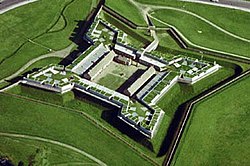Fort Stanwix | |
 Aerial view of the Fort Stanwix reconstruction | |
| Location | 100 North James St., Rome, New York |
|---|---|
| Coordinates | 43°12′38″N 75°27′19″W / 43.21056°N 75.45528°W |
| Area | 16 acres (6.5 ha) |
| Built | 1758 |
| Visitation | 84,933 (2002) |
| Website | Fort Stanwix National Monument |
| NRHP reference No. | 66000057 |
| Significant dates | |
| Added to NRHP | October 15, 1966[1] |
| Designated NHL | November 23, 1962[2] |
| Designated NMON | August 21, 1935 |
Fort Stanwix was a colonial fort whose construction commenced on August 26, 1758, under the direction of British General John Stanwix, at the location of present-day Rome, New York, but was not completed until about 1762. The bastion fort was built to guard a portage known as the Oneida Carry during the French and Indian War. Fort Stanwix National Monument, a reconstructed structure built by the National Park Service, now occupies the site.[3]
Fort Stanwix is historically significant because of its successful defense by American troops during an August 1777 siege. The fort had been built by the British in 1758 at a strategic site along the water route from Lake Ontario to the Hudson River. After American forces captured and rebuilt the fort during the American Revolutionary War, they were besieged by a British army that invaded from Canada via Lake Ontario, hoping to reach the Hudson River. The British force abandoned the siege, a consequence that helped lead to the defeat of a larger British army during the Saratoga campaign.
Fort Stanwix was also the site of the 1768 Treaty of Fort Stanwix between Britain and Native American tribes, as well as of the 1784 Treaty of Fort Stanwix between the tribes and the American government.
Besides the fort reconstruction itself, the national monument includes three short trails that encircle it, one of which follows a portion of the Oneida Carry. The Marinus Willett Collections Management and Education Center preserves the monument's 485,000 artifacts and documents, displays exhibits about Fort Stanwix and the Mohawk Valley, and serves as a regional tourism center.[4]
- ^ "National Register Information System". National Register of Historic Places. National Park Service. January 23, 2007.
- ^ "Fort Stanwix". National Historic Landmark. National Park Service. 13 September 2007. Archived from the original on 13 May 2011. Retrieved 15 July 2018.
- ^ "Fort Stanwix National Monument (U.S. National Park Service)".
- ^ "Willet Center". Archived from the original on 2008-10-18. Retrieved 2021-09-18.

